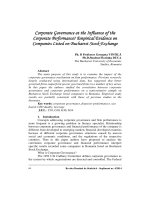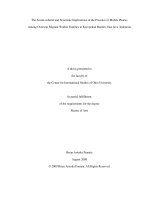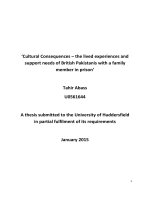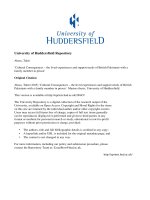Cultural and religious values of caregivers at end of life care the case of hospice ethiopia palliative center, addis ababa ethiopia
Bạn đang xem bản rút gọn của tài liệu. Xem và tải ngay bản đầy đủ của tài liệu tại đây (853.85 KB, 132 trang )
RUNNING HEAD: CULTURAL AND RELIGIOUS VALUES…
Cultural and Religious Values of Caregivers at End of Life Care: The Case of Hospice Ethiopia
Palliative Center, Addis Ababa Ethiopia
By: Mahlet Endalku Beshah
A Thesis Submitted to School of Social Work, Addis Ababa University Presented in Partial
Fulfilment of the Requirements for the Degree of Master of Social Work
Addis Ababa University
Addis Ababa Ethiopia
July 2017
Cultural and Religious Values…
Cultural and Religious Values of Caregivers at End of Life Care: The Case of Hospice Ethiopia
Palliative Center, Addis Ababa Ethiopia
By: Mahlet Endalku Beshah
Advisor: Zena Berhanu (PhD)
A Thesis Submitted to School of Social Work, Addis Ababa University Presented in Partial
Fulfilment of the Requirements for the Degree of Master of Social Work
Addis Ababa University
Addis Ababa Ethiopia
July 2017
Cultural and Religious Values…
Addis Ababa University
School of Graduate Studies
This is to certify that the thesis prepared by Mahlet Endalku, entitled Cultural and Religious
Values of Caregivers at End of Life Care: The Case of Hospice Ethiopia Palliative Center and
submitted in partial fulfillment of the requirements for the Degree of Master of Arts (Social
Work) complies with the regulation of the University and meets the accepted standards with
respect to originality and quality.
APPROVED BY THE EXAMINING BOARD
Examiner _______________ Signature ____________ Date ____________
Examiner _______________ Signature ____________ Date ____________
Advisor _______________ Signature ____________ Date ___________
Cultural and Religious Values…
Declaration
I declare that Cultural and Religious Values of Caregivers at End of Life Care: The Case of
Hospice Ethiopia Palliative Center is my own work. All the sources that I have used or quoted
have been indicated. I have acknowledged by means of reference and that this work has not been
submitted before any others degree at any other institution.
Mahlet Endalku Beshah
Signature: ___________________________
Date: _______________________________
Place: Addis Ababa University, Ethiopia
Cultural and Religious Values…
Abstract
Death and dying issue is what we humans find inevitable but most uncomfortable topic to
discuss. In a country like Ethiopia, such topics are taken as a taboo and feared to talk about
death and dying from the religious and cultural value we hold. This thesis is a qualitative
exploratory case study aimed at cultural and religious values of caregivers at end of life care.
The caregivers are both family and professional caregivers who provide care for people on the
verge of death. The tools for primary data collection were in-depth interviews and observation in
order to gain in-depth information. Purposive sampling technique was used to select participants
leading to three professional caregivers and eight family caregivers. The finding of this study
indicated that cultural and religious values have a great contribution while caring for people at
the verge of death. It is important to give values as it has impact on the action of caregivers. In
addition, the availability and use of social support has a great contribution and there are family
members who are suffering lacking such support. Due to the cultural and religious values, family
members have experienced lives that are stressful in care giving. Therefore, the finding has a
good contribution for social work implication as the school of social work should incorporate
courses that would give social workers a great skill and knowledge of palliative care. Regarding
to practice, it is quite important to work with like-minded organization as to plan trainings,
seminars and experience sharing programs. The finding showed that there is a lack of social
work intervention in the area and it is important to study the view of clients themselves in the
service provision. As the Ministry of Health is now giving attention to palliative care having the
unit under its umbrella, there should be funding and human resources that could benefit for the
quality of service provision and addressing large number of people.
Key Words: End of life Care, Cultural Values, Palliative Care and Religious Values
i
Cultural and Religious Values…
Acknowledgment
As for achieving and do my very best on this thesis, the unquestionable effort and support
from my advisor from Zena Berhanu (PhD) cannot be left without giving the gratitude which is
needed high most. He has been providing constructive comments and suggestions that made me
able to produce this thesis work and ready to be defendable. I would like to thank the
professional caregivers from Hospice Ethiopia who have given me all their time and energy in
getting information and organizing home to home visits so that I can collect the data from the
family caregivers who are also the core of this work as they provided me a good knowledge base.
With a great hope looking forward, I would like to thank all my families and friends who have
contributed one way or the other for this work. Thank you God who has been the strength
through all my weaknesses.
ii
Cultural and Religious Values…
Table of Content
Content
Page
Abstract .………………………………………………….….…..…………………..
i
Acknowledgement ………………………………………………………….…..……….. ii
Table of content ………………………………………………………….…..…………… iii
Acronym ………………………………………………………….…..…………………. viii
Chapter one
Introduction
1.1 Background of the Study …….…………………………………...…………….…….. 1
1.2 Statement of the problem ……….………………………………...…………….….
4
1.3 Research Questions ……………….……………………………..………………….. 8
1.4 Research Objective
1.4.1 General Objective ……………………………..…………...….………………… 8
1.4.2 Specific Objectives ……………..……………….…..………………………….. 8
1.5 Scope of the Study ……………………………..…………………………………… 9
1.6 Significance of the Study ………………………………………………………….
9
1.7 Theoretical Frameworks ………………...…..……………………………………. 10
1.7.1 Systems Perspective………………...….…………………………………… 11
1.7.2 Ecological Perspective ……………………………………………………… 12
1.7.3 Family Stressor Theory …………….……………………………………….. 12
1.7.4 Bio-psychosocial and Spiritual Model ………………...……………………. 13
1.7.5 Spiritual Model ……………………………………………………………… 13
1.7.6 Existential …………………………………………………………………… 14
iii
Cultural and Religious Values…
1.8 Limitation of the Paper……………………………………………………………….. 15
1.9 Organization of the paper ……………………………………………………………. 15
1.10 Operational Definition …………………….………………………………………… 16
Chapter Two
Literature Review
2.1 What is End of life care?...................................................................................... 17
2.2 Breaking bad news …………………………………………………………… 19
2.3 Truth telling …………………………………………………………………… 19
2.4 Death, Loss and Grief ………………………………………………………… 21
2.5 What is palliative care? ……………………………………………………… 22
2.6 Role of Caregivers in Palliative care ………………………………………… 24
2.7 Spirituality and Religious Views at End of Life Care………………………… 25
2.8 Culture and Medical Care …………………………………………………… 28
2.9 Culture as a Social Support. …………………………………………………… 29
2.10 Communication in End of Life Care ……………………………………..… 30
2.11 Ethical Issue and End of Life Care ………………………………………… 31
2.12 Summary …………………………………………..………………………… 33
Chapter Three
Research Methods
3.1 Researcher’s Perspective …………………………………………………………… 35
3.2 Research Design …………………………………………………………………… 36
iv
Cultural and Religious Values…
3.3 Selection of Site to Access Research Participants ………………………………… 37
3.4 Sampling and Sample Size ………………………………………………………… 38
3.5 Method of Data Collection ………………………...……….……………………… 39
3.5.1 In depth Interview ……………………………………………………..…… 39
3.5.2 Observation ………………………………………………………………… 40
3.6 Data Collection Process …………………………………………………………… 41
3.7 Method of Data Analysis …………………………………………………………… 42
3.8 Quality Assurance ………………………………………………………………… 43
3.9 Ethical consideration ………………………………………………………………. 44
3.10 Summary ………………………………………………………………………… 46
Chapter Four
Data Presentation
Description of Research Participants …………………………………………………
47
4.1 Understanding the Service Provision at End of Life Care …………………………… 48
4.1.1 Holistic service provision for patients ……………………………………… 49
4.1.2 Service given to the family caregivers or members ………………………… 51
4.1.2.1 Decision Making ………………………………………………………51
4.1.2.2 Loss, Grief Management and Death preparation………………………52
4.2 Explanation of Caregivers about Cultural Values at End of Life Care ………………
53
4.2.1.1 Reservation for Discussion ……………………………………………….
53
4.2.1.2 Breaking Bad News…………...…………………………………………… 55
4.2.2.1 The different views on the availability and use of Social support………… .57
4.3 Religious Components at End of Life Care Treatment …………………….……………60
v
Cultural and Religious Values…
4.3.1.1 Level of Spiritual Strength……………………………………..………… 60
4.3.2.1 God is in Action ………………………………………………………… 62
4.4 Impact of cultural and religious views on the action of caregivers …………………… 63
4.1 Patient autonomy ……………………………………………………………… 63
4.5.1 Communication Between Family Members And Professional Caregivers ….……… 63
4.5.1.1 Ethical Issue ……………………………………………………………… 63
4.5.1.2 Talking about Death and Dying …………………………………………… 66
4.5.2 Communication Between Clients And Professional Caregivers ………………….. 67
4.5.2.1 Professional value Vs Cultural Value..……………………………………. 67
4.5.2.2 Clients Who Do Not Want To Hear ……………………………………… 67
4.5.2.3 Clients Who Are Ready To Hear ………………………………………… 68
4.6 Experiences Of Caregivers At End Of Life Care ………………………………………70
4.6.1 Professional Self Vs Personal Values.………………………………………. 70
4.6.2 Experiences Of Family Caregivers …..…………………………………….. 72
4.6.2.1 Fear To Let Go ……………………….…………………………………… 72
4.6.2.2 God Has A Plan …………………………………………………………… 73
4.6.2.3 Challenging Situation ………………………………………………………73
4.6.2.3 Availability Of Social Support…………………………………………… 75
4.7 Summary …………………………………………………………………………… …76
vi
Cultural and Religious Values…
Chapter Five
Discussion
5.1 Understanding The Service Provision At End Of Life Care ………..……………… 78
5.2 Explanation Of Caregivers About Cultural Values At End Of Life Care ………… 80
5.3 Religious Components At End Of Life Care Treatment ……….…………….…… 83
5.4 Impact Of Cultural And Religious Views On The Action Of Professional Caregivers 85
5.5 Communication Between Professional Caregivers And Clients As Well Family
Members…
………………………………………………………………………………..85
5.6 Experiences Of Caregivers At End Of Life Care……………………..…………… 87
5.7 Discussion Summary ………………………………………………………………….. 88
Chapter Six
Conclusion and Implication For Social Work
6.1 Conclusion ……………………………………….…………………………………… 90
6.2 Implication For Social Work
6.2.1 Implication For Social Work Education ……………………………………………. 94
6.2.2 Implication For Social Work Practice ………………………………………………. 95
6.2.3 Implication For Research …………………………………………………………… 96
6.2.4 Implication For Policy And Program ……………………………………………….. 97
References …………………………………………………………………………………..ix
Annex ………………………………………………………………………………………xix
vii
Cultural and Religious Values…
Acronyms
AIDS- Acquired Immune Deficiency Syndrome
ESSSWA- Ethiopian Society of Sociologists, Social Workers and Anthropologists Association
HIV- Human Immune Virus
MOH- Ministry of Health
MSW- Masters of Social Work
NASW- National Association of Social Work
NCPC- National Council of Palliative Care
NSW- National Social Work
TB- Tuberculosis
WHO- World Health Organization
viii
Cultural and Religious Values…
Chapter One
Introduction
1.1 Background of the Study
End of life care is a point in life that people on the verge of death require the gentlest and
comfortable environment. It is my belief that when people are reaching to their death, it is
important to attend them in ways they want without our own beliefs and attitude. As human
beings, the attitude we have towards death might affect our approach for the care we owe our
loved ones, as we usually think of life after death for them and how we would end up losing
them. End of life can be understood as a continuum of events starting with the diagnosis of one
or more serious illnesses or injury. Each of these conditions has a trajectory, some more
predictable than others. The range of illnesses relevant to end-of-life decision making
encompasses the leading causes of death in the population such as cardiovascular disease,
pulmonary disease and cancer (Schuklenk, Delden, Downie, McLean, Upshur& Weinstock,
2011).
The practice of end of life care is now being common as there are lots of people
approaching the required care. Through the advancement of technology and social
transformation, it is possible to find clients admitted to this care. Older adults with age related
health problems as well as patients including children who are terminally ill are those treated at
end of life care. Diseases requiring palliative care for adults are mostly Alzheimer’s and other
dementias, cancer, cardiovascular diseases (excluding sudden deaths), cirrhosis of the liver,
chronic obstructive pulmonary diseases, diabetes, HIV/AIDS, kidney failure, multiple sclerosis,
Parkinson’s disease, rheumatoid arthritis, drug-resistant tuberculosis (TB). The care includes
children when they are diagnosed with cancer, cardiovascular diseases, cirrhosis of the liver,
1
Cultural and Religious Values…
congenital anomalies (excluding heart abnormalities), blood and immune disorders, HIV/AIDS,
meningitis, kidney diseases, neurological disorders and neonatal conditions (Worldwide
Palliative Care Alliance, 2014).
Caregivers are the ones who provide support to someone who needs help. It does not
matter how many hours per week are spent providing support. Caregivers may live with the
person they are caring for, providing assistance with daily needs, or may visit the person weekly
or call regularly. Being a caregiver involves an investment in time, energy and support (National
Hospice and Palliative Care Organization, 2005). On a different line there are also paid
caregivers are hired to keep the patients’ safe and pain free. They look after his or her wellbeing. Unlike the family or unpaid caregivers, these caregiver and care recipient might form a
bond over time, but it is important that paid caregivers maintain professional boundaries. They
should not become involved in familial or financial conversations and decision-making (Family
Caregiver Alliance, 2016). When we think of end of life care, it is possible to think of the
cultural and religious components as well as it equally matters like clinical treatment. Bennett
(2012) showed that how we let our clients to make decisions on organ donation, placed to be
cared at and priorities are influenced by cultural and religious values.
Dying people needs special attention as they feel depressed and anxious. It is also
important to care for their physical pain as they need intensive follow up. It is quite possible
finding people on their death bed requesting for time alone with friends and families and make
conversation with religious community (National Institute on Aging, 2012).
Cass, Lowell, Christie, Snelling, Flack, Marrnganyin& Brown (2002), explained the
importance of communication in end of life care. They noted that there should be common
understanding as to consider the background, histories, languages and cultures between families
2
Cultural and Religious Values…
and staff. Relating to this point, the issue of ethics is also important point to consider at end of
life care. Murray & Jennings (2005) suggested that our approach to death and dying in health
care has been excessively rationalistic and that end-of-life decision-making has been excessively
individualistic, with too much emphasis on autonomy instead of caring, family solidarity, love,
mutual respect and attentiveness.
The service of end of life care also considers family members on how they can handle
themselves after the death of their loved one. It is shown by Singg (2009), that family members
as well as patients pass through stages of denial, anger, bargaining, depression, and acceptance as
to consider letting go their family member and their death for the patients too.
Cultural and religious value plays a great role at end of life care as we need to consider
the interest of patients. We tend to neglect the substantial differences in the way people of
different cultures perceive, experience and explain illness and death. Often, it is likely to find
patients and health-care workers falling under the pressure of unspoken assumption about health,
illness and dying as they are from different cultural backgrounds (Jecker, Carrese& Pearlman,
1995). When we see end of life care these days it is visible that spiritual care is also considered a
basic lead of palliative care. The spiritual component is vital to be cared of as to make holistic
palliative care. But it is important to first consider and distinguish the dying person’s spiritual,
religious and existential needs as to make appropriate intervention (Scott, Thiel &Dahlin, 2008).
The purpose of this study was to explore the views of caregivers at end of life care
through the eyes of cultural and religious values. This study indicated how our Ethiopian culture
can contribute to the care we provide and how to incorporate religious aspects at end of life care.
It also implied to give a baseline for the caregivers as family members who are unpaid and
caregivers as professionals.
3
Cultural and Religious Values…
1.2 Statement of the problem
There have been many researchers who conducted studies on End-of-life care. Through
my search of the literature, I have found researches conducted on cultural and spiritual view
towards end of life care, strategies and principles in end of life care, loss and grief, palliative care
and its challenges and role of social workers in end-of-life care. Sissay (2016) conducted a study
on knowledge and attitude of nurses towards palliative care in government health hospitals in
Addis Ababa. The result showed that there is poor knowledge about palliative care but most
nurses have favorable attitude towards it. Nurses’ level of education, working department, years
of working experiences, experience in caring chronically ill patient and in service training of
palliative care had significant association with their attitude towards palliative care. This is to
mean that when the nurses have a longer work experience and early exposure to palliative care,
they tend to have a positive attitude towards the care for their patients. The working department
is the situation that if they have not been placed to get the chance to care for such patients at end
of life care, they might have no understanding for the service. The training and the level of
education similarly affects how they would respond to their patient at end of life care.
Similarly, nurses’ knowledge, practice and associated factors towards pediatrics palliative
care in Addis Ababa government hospitals was studied by Alemnesh (2014) and found that
caring for someone with a life-limiting condition can be challenging on both an emotional and
practical level. This study showed knowledge, practice, and training deficit of nurses to give
pediatrics palliative care.
Bosma, Johnston, Cadell, Wainwright, Abernathy, Feron, Kelley & Nelson (2008)
explored role of social workers in Canada Palliative care. They indicated that the Canada social
workers’ competencies such as advocacy, assessment, care delivery, care planning, community
4
Cultural and Religious Values…
capacity building, evaluation, decision-making, education and research, information sharing,
interdisciplinary teamwork, and self-reflective practice.
It is often said that appreciating differences in others helps us better understand ourselves,
and that this is what ultimately unites humankind. Nobel Peace Prize winner Kofi Annan said,
“We may have different religions, different languages and different colored skin, but we all
belong to the same human race.” The same is true for End-of-Life our cultures, ethnicities and
faiths may differ, yet End-of-Life is something we will all experience (Passare, 2013).
Jones (2002) examined that choices involving end of life medical treatment decisions
may be more related to ethnicity and culture than to age, education, socio economic status, or
other variables. It is noted that despite the living differences we make in education or wealth at
the end of the day all human beings are the same in facing death. The cultural values we hold
affect us more than the differences we make in age, education or social status. Thus it is essential
for healthcare providers to recognize the basic values, principles and assumptions of western
medicine and bioethics as they are historically situated and culturally determined.
When we understand culture from an individual lens we should look beyond his/her
ethnicity and give attention to other learned beliefs and values that evolve over a person’s life.
Cultural diversity is associated with differing belief systems regarding death and dying in
Australian culture. General practitioners are challenged to provide medical care within the
context of an individual’s bio-psychosocial needs. Despite disparate beliefs, universal care (i.e.
the needs all patients require despite their cultural diversity such as provision of comfort,
appropriate communication, self-determination and informed decision making) needs valued at
the end of life include the provision of comfort, appropriate communication between the patient
5
Cultural and Religious Values…
and doctor, respect for spiritual beliefs, and the opportunity for the dying person to say goodbye
(Clark & Phillips, 2010).
In Hindu’s perspective, large number of families and friends tend to get closer to the
dying person. It is likely to whisper religious words or Mantra into the ears of the dying person.
Usually, family members like to stay with the patient when they are dying. A thread with
religious significance may be tied around the wrist or neck by a priest. The person may choose to
lie on the floor in order to be close to Mother Earth when they die. In this regard it is noted that
nurses need to be sensitive to their needs and feelings and allow at least one female relative to
stay with them (O'Connor &Sellick 2010).
Campbell & Amin (2014) gave well illustrated knowledge on the importance of
traditional practices around illness, dying, death and bereavement in a rural Zulu (South Africa)
community. Traditional healers have knowledge of local traditional practices, referred to as
indigenous knowledge. In the study, the benefit of the traditional healers’ involvement was the
provision of psychological care for patients as they were the first practitioners to introduce the
care thinking about the whole person.
Nursing care and responsibilities to the dying patient and their family do not end with the
death of the patient. Potential loss and grief issues should be assessed upon admission of the
patient, and bereavement care should continue after their death. Like all healthcare professionals,
nurses must recognize and respond to their own grief in order to provide quality palliative care to
the dying patient and their family (Matzo, Sherman, Lo, Egan & Rhome, 2003).
Ayers (2014) conducted a study on management of emotions in caring for the dying. The
study contributes knowledge and understanding as it offers evidence surrounding non-disclosure
6
Cultural and Religious Values…
of cancer diagnosis, prognosis and dying in Addis Ababa predominantly by family members.
The new contribution it gave is that the study gave new insight and explored caring for the dying
person from ethnographic point of view. It showed a way how to provide novel insight into care
behavior, through presenting evidence of the emotional work surrounding the new concept of
‘accompanied dying’. Accompanied dying illustrates how the family offers their ‘companionable
presence’ to offer emotional support and care to their dying loved one. This is done by family
care givers showing deference to the person who is dying through the emotional work. Finally,
the priority of emotional care to the dying person by family and hospice staff as emotional care is
expressed through action in our society. This explains that how practitioners respond emotionally
to their clients is the reflection of the norms in the society.
In the previous paragraphs a lot have been said on end of life care as it is part of the
palliative care. When we are caring for the person on the verge of death we also consider the loss
and grief management. Looking through the issue from different points, it was possible to gain
the knowledge of end of life care from different cultural and religious perspectives. I was also
interested to find related research conducted on this area but I could not find any through my
review of literature. I was looking forward to know on how our society responds to end of life
care, as palliative care is newly introduced in our society. Even if the practice is now emerging
and there are two centers in the city, only two researches have been conducted on palliative care
and social work perspective is missing in both researches. As to fill the existing knowledge gap it
was my interest to explore cultural and religious values of caregivers at end of life care. This
would also serves as a baseline for caregivers and service providers from multidiscipline to be
aware of our own culture and religion that would impact professionals when we care for people
at end of life care.
7
Cultural and Religious Values…
1.3 Research Questions
What are the services given at end of life care?
How do caregivers explain cultural values at end of life care?
How do caregivers explain religious values at end of life care?
What are the impacts of religious and cultural values on the action of caregivers?
How do caregivers communicate with family members and clients when they are on the
verge of death?
What are the experiences of caregivers at end of life care?
1.4 Research Objectives
1.4.1 General Objective
Exploring the cultural and religious values of caregivers at end of life care
1.4.2 Specific Objectives
To explore the service provision at end of life care for both clients and family members
To explore the explanation of caregivers towards end of life care in their cultural values
To explore the explanation of caregivers towards end of life care in their religious value
To find out the impacts of cultural and religious values on the actions of caregivers
To investigate the communication between professional caregivers, clients and family
members
To explore the experiences of caregivers at end of life care
8
Cultural and Religious Values…
1.5 Scope of the Study
This study is delimited to assess the care provided for clients and family members at end
of life care. It covered the communication between caregivers and clients as well as family
members. As it is going to explore only from the side of caregivers, it is delimited from assessing
the clients’ point of view on religion and culture at end of life care. The study incorporated the
views and experiences caregivers have for their clients as they are on the verge of death. It also
studied how professional caregivers address the needs of caregivers as family members. It also
studied how caregivers’ particularly family members will await loss and grief. Concerning all
this, the study is limited its scope at exploring caregivers’ cultural and religious value towards
death and dying at end of life care at Hospice Ethiopia center.
1.6 Significance of the study
Death despite its timely occurrence, it affects both who is on the verge of dying and those
who are caring for the person. As a social learning theory explains, how we interact with the
environment affects how we respond to life phenomena. In line with that, how we approach
death as people on the verge of dying and as people caring for them is affected by how we
perceived the meaning of death.
This research would help caregivers to value their care for their significant others or
clients to see their wishes and needs despite the image created as thinking of death. An in-depth
study of caregivers’ religious and cultural value would help both clients and caregivers for death
preparation and grief management respectively. It will also help practitioners especially social
workers in palliative care to consider bio-psychosocial and spiritual model in their service
provision as it would make the service worthwhile for a country like Ethiopia. It will benefit
9
Cultural and Religious Values…
practitioners from multidiscipline as well to incorporate the issue of culture and religion in their
service provision.
As this research also studied on a palliative care providing center, it would help to
introduce palliative care in Addis Ababa and largely to Ethiopia as well in contextualizing it with
our culture. Lastly it will serve as a baseline for future researchers to study on the area as to fill
the knowledge gap by studying end of life care from different points of view.
1.7 Theoretical Frameworks
The theoretical framework is the foundation from which all knowledge is constructed
(metaphorically and literally) for a research study. It serves as the structure and support for the
rationale for the study, the problem statement, the purpose, the significance, and the research
questions. The theoretical framework provides a grounding base, or an anchor, for the literature
review, and most importantly, the methods and analysis (Grant & Osanloo, 2014). Similarly,
Wilkinson (1991) showed the importance of having theoretical frameworks in research as it
helps readers to understand how it is related to other research.
For undertaking this research, I chose four theories in which can be related with my idea.
The first one is the systems perspective as in which we can understand about interrelationships
and how one affects the other. It would also helped me to understand participants of the study
with that of their interaction with the environment. Using the ecological perspective as well can
benefit the research to see from where problems and different understandings arise as a product
of interaction of psychological, social, economic, political and physical forces in which help to
assist clients at different level. Family stressor is the other framework I used for studying this
research. This theory helped me to support my research area to see how the change that occurs in
10
Cultural and Religious Values…
one family affects the others. Especially as the theory is explained in relation with the
availability of resources and means, it is possible to understand the stressful situation in the
family. Here also it is possible to look whether the family can adapt the change in the family
situation or not.
Lastly the Bio-Psychosocial and spiritual model is taken into account as it makes
practitioners’ service holistic. Currently, the integration of these four elements in service
provision is taken as most effective and best for clients. As we are working with human beings, it
is not possible to neglect one of these elements in studying their social problem. It is also
possible to note that, not only for assessing a certain problem when we are intervening as well
we need to use these elements as resources. Thus with all the above mentioned elements being
highly used while the researcher was undertaking the study and especially as the aim is exploring
the values of caregivers towards death and dying through cultural and religious values the
concept of the last theory was very vital and supportive.
1.7.1 Systems Perspective
Systems theory emphasizes reciprocal relationships between the elements that constitute
a whole. These concepts also emphasize the relationships among individuals, groups,
organizations, or communities and mutually influencing factors in the environment (Payne,
1997). Systems theories focus on the interrelationships of elements in nature and shows how one
depends on the other. It also shows how the system is affected when the one is not functioning
well. Anderson, Carter & Lowe, (1999) also explained systems theory is a way of elaborating
increasingly complex systems across a continuum that encompasses the person-in environment.
It also enables us to understand the components and dynamics of client systems in order to
11
Cultural and Religious Values…
interpret problems and develop balanced intervention strategies, with the goal of enhancing the
“goodness of fit” between individuals and their environments.
1.7.2 Ecological perspective
The present thinking on the ecological approach suggests that the primary premise
explaining human problems is derived from the complex interplay of psychological, social,
economic, political and physical forces. This perspective allows the practitioner to effectively
treat problems and needs of various systemic levels including the individual, family, the small
group, and the larger community. The client's ecosystem is the interrelationships and
conglomeration of these ecologies. It consists of the self, family, the neighborhood, and the
entire community. Consequently, the client's ecosystem is composed of numerous overlapping
systems including the family, the workplace, and the community, as well as other critical
subsystems unique to each client (Pardeck, 1998).
1.7.3 Family Stress Theory
Boss (2002), explained stress is a normal part of family experience, in light of the
inevitability that the family will grow and develop, causing change to occur within the family
system. This change, which can be either positive or negative, is essentially equivalent to family
stress. The impact of change on the family depends upon how adequately a family either
manages or adapts to stress and how effectively the family’s resources allow them to cope.
Generally, family stress becomes problematic when the level of stress causes a disturbance
within the family system or its individual family members. Wilmoth (2009) explained the ABC’s
as for A is the stressor event is defined as an occurrence, positive or negative, that either changes
or has the potential to change the family system. B stands for the family resource which are
12
Cultural and Religious Values…
assets that help the family prevent or buffer an event from causing a crisis state and assist the
family in problem solving to enhance the family’s coping strategies. Family resources are the
individual members, the collective family and the community. These meaning are the C in the
model in which explains family’s perception, appraisal, or assessment of a stressor event, are
interpretations and views that the family has collectively formed while interacting with one
another. On a similar case, Patterson (2002) showed how families construct meanings about the
stressor, family identity, and their worldview. Some situations become sources of stress only
because they are perceived by the family to be stressful.
1.7.4 Bio-psychosocial and spiritual model
According to Frankel, Quill & McDaniel (2003), the bio-psychosocial approach
systematically considers biological, psychological, and social factors and their complex
interactions in understanding health, illness, and health care delivery. Lukoff, Turner, &
Gackenbach (1995), showed how transpersonal-spiritual-religious perspective integrates with
approaches like psychodynamic, behaviorist, humanistic, cognitive, biological, evolutionary, and
sociocultural. Human nature is not a finished product, but the sort of consciousness meant to
change, evolve and develop. It is now in a state of transition, one of many, as is demonstrated by
the striking increase of interest in things "spiritual" in modern times.
1.7.5 Spiritual Model
Spirituality is a fundamental element of human experience. It encompasses the
individual’s search for meaning and purpose in life and the experience of the transcendent.
Spirituality also encompasses the connections one makes with others, his or herself, nature, and
to the sacred realms, inside as well as outside of traditional religion. Viewed in this way,
13









